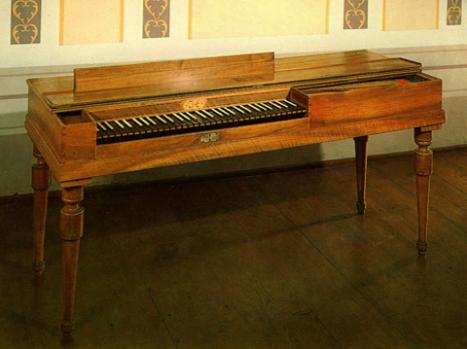Teh unfretted clavichord

Unfretted clavichord, Ferdinand Hoffmann, Vienna, circa 1785-95; Vienna, Haydn Museum (from the possession of Johannes Brahms)
This is a relatively late instrument and a typical example of the comparatively large-format clavichords of that era. In direct competition with the square piano, the clavichord still had its admirers even after 1800, who appreciated the clavichord's direct touch.
Music example:
Excerpt from Joseph Haydn, Moderato C minor Hob. XVI:20 (Fragment)
played by Christine Schornsheim.
Instrument: Burkhard Zander, copy of a fretless clavichord by J.G. Horn 1788.
The term "bundfreies Clavichord" (unfretted clavichord) is understood as the opposite of the "gebundenes Clavichord" (fretted clavichord) and denotes that each note/key has its own set of strings, meaning that multiple notes are not bound to a single set of strings as common before. The unfretted clavichord experienced its peak in the 18th century, and during this time it was at least in Central and Northern Europe the classic household instrument until the gradual advent of the square piano. It was an indispensable tool for all those professionally involved with music; it is known that most composers of that time composed on and with the clavichord.
The instrument shown here is a typical example: it was built by Ferdinand Hofmann in Vienna between 1785 and 1795 and probably belonged to Johann Elßler, Haydn's servant and copyist, and supposedly to Joseph Haydn himself for some time; later, it was owned by Johannes Brahms. It is a relatively late example, but clavichords were occasionally still built and used after 1800.
Around the mid-18th century, some German instrument makers attempted to increase the volume of the clavichord by initially enlarging the instrument itself to nearly double its size. The Hass family in Hamburg then added an additional 4-string set in the bass register, while Friderici in Gera experimented with overspun strings. Finally, Gottfried Silbermann built an instrument with strings twice the usual length that were struck exactly in the middle so that the string could vibrate on both sides of the tangent. He misleadingly called his instrument "Cembal d'amour."
With these structural changes, clavichords were still somewhat suitable for chamber music in combination with soft instruments like the transverse flute or a muted string instrument and could thus keep up in volume with early square pianos or smaller spinets. However, a limit was reached beyond which it could not be further increased, while pianofortes became progressively louder and fuller in sound around and after 1800, gradually displacing the clavichord from its traditional indoor field of use.



